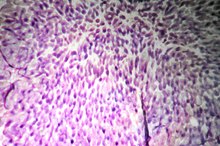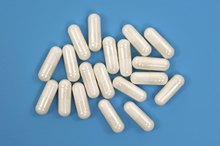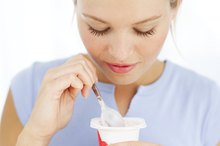What does fact checked mean?
At Healthfully, we strive to deliver objective content that is accurate and up-to-date. Our team periodically reviews articles in order to ensure content quality. The sources cited below consist of evidence from peer-reviewed journals, prominent medical organizations, academic associations, and government data.
The information contained on this site is for informational purposes only, and should not be used as a substitute for the advice of a professional health care provider. Please check with the appropriate physician regarding health questions and concerns. Although we strive to deliver accurate and up-to-date information, no guarantee to that effect is made.
Does Activia Help With a Yeast Infection?
Many women treat vaginal yeast infections with over-the-counter medications, while others prefer alternative remedies. One yeast infection remedy recommended by holistic medicine professionals is taking probiotics, or helpful bacteria. Activia is a brand of yogurt that contains probiotic bacterial cultures that may improve yeast infection symptoms. Before treating your yeast infection with Activia yogurt, talk to a doctor to make sure it is safe.
If you are experiencing serious medical symptoms, seek emergency treatment immediately.
Yeast Infection Symptoms
Although yeast naturally live in your vagina, they can cause problems when they are in large numbers. A yeast infection occurs when your vaginal yeast populations suddenly rises. Common symptoms of a yeast infection include vaginal itching, a thick discharge that resembles cottage cheese, redness, swelling and a burning sensation during urination. Using alternative remedies may reduce your vaginal yeast population to normal levels, alleviating yeast infection symptoms.
- Although yeast naturally live in your vagina, they can cause problems when they are in large numbers.
- Using alternative remedies may reduce your vaginal yeast population to normal levels, alleviating yeast infection symptoms.
Activia Features
List of Good Bacteria
Learn More
Activia is a brand of yogurt manufactured by Dannon. Although Dannon markets Activia as a natural way to improve digestive regularity, it may have other health benefits. Activia yogurt contains a probiotic bacterial strain called Bifidobacterium lactis DN-173 010, also known by its trademarked name Bifidobacterium regularis. Bifidobacterium cultures survive your stomach acid and pass through your digestive system to colonize the intestines.
- Activia is a brand of yogurt manufactured by Dannon.
- Activia yogurt contains a probiotic bacterial strain called Bifidobacterium lactis DN-173 010, also known by its trademarked name Bifidobacterium regularis.
Activia Use
Some people use Activia yogurt as an alternative medicine treatment for vaginal yeast infections. According to the University of Maryland Medical Center, some research supports the use of probiotic yogurt to treat yeast infections, while other research finds that yogurt is not an effective remedy 4. Taking 10 billion colony-forming units of bifidobacterium per day is considered an appropriate dose for yeast infection treatment. The Activia website states that about 3 1/2 oz. of Activia yogurt contains 1 billion live, active bacteria. To get enough bifidobacterium through yogurt alone, you would need to eat over 30 oz. of Activia per day 3.
Considerations
Acidophilus & Gastritis
Learn More
Eating Activia yogurt to populate your intestines with probiotics is not harmful, but it may not treat a yeast infection as well as conventional remedies. Some evidence suggests that other probiotic strains, such as Lactobacillus acidophilus or Lactobacillus GG, may be better remedies than bifidobacterium 5. Discuss your yeast infection symptoms with a doctor to determine whether Activia yogurt is an appropriate treatment for you.
Related Articles
References
- MedlinePlus: Bifidobacteria
- Activia: Frequently Asked Questions
- Activia: How Can Activia Help Me
- University of Maryland Medical Center: Candidiasis
- Medline Plus: Lactobacillus
- Martin Lopez JE. Candidiasis (vulvovaginal. BMJ Clin Evid. 2015 Mar 16;2015:0815
- National Center for Biotechnology Information. Vaginal candidiasis (vulvovaginal candidiasis). Updated February 24, 2019.
- Sobel JD. Patient education: Vaginal yeast infection (beyond the basics). UpToDate, Inc. Updated February 7, 2019.
- Zomorodian K, Kavoosi F, Pishdad GR, et al. Prevalence of oral Candida colonization in patients with diabetes mellitus. J Mycol Med. 2016;26(2):103-110. doi:10.1016/j.mycmed.2015.12.008
- Moshfeghy Z, Tahari S, Janghorban, et al. Association of sexual function and psychological symptoms including depression, anxiety and stress in women with recurrent vulvovaginal candidiasis. J Turk Ger Gynecol Assoc. 2020 Jun; 21(2): 90–96. doi:10.4274/jtgga.galenos.2019.2019.0077
- Brunham RC, Gottlieb SL, Paavonen J. Pelvic inflammatory disease. N Engl J Med. 2015;372(21):2039-48. doi:10.1056/NEJMra1411426
- Zhu Y, Bateman BT, Gray KJ, et al. Oral fluconazole use in the first trimester and risk of congenital malformations: Population based cohort study. BMJ. 2020; 369: m1494.doi:10.1136/bmj.m1494
- Behmanesh F, Pasha H, Sefidgar AA, et al. Antifungal effect of lavender essential oil (Lavandula angustifolia) And clotrimazole on candida albicans: An in vitro study. Scientifica (Cairo). 2015;2015:261397. doi:10.1155/2015/261397
- Mertas A, Garbusinska A, Szliszka, E, et al. The influence of tea tree oil (Melaleuca alternifolia) On fluconazole activity against fluconazole-resistant candida albicans strains. Biomed Res Int. 2015; 2015: 590470. doi:10.1155/2015/590470
- Ferris DG, Nyirjesy P, Sobel JD, et al. Over-the-counter antifungal drug misuse associated with patient-diagnosed vulvovaginal candidiasis. Obstet Gynecol. 2002 Mar;99(3):419-25. doi:10.1016/s0029-7844(01)01759-8
- Department of Health & Human Services. Office on Women's Health. Vaginal yeast infections. Apr 1, 2019.
- Iavazzo C, Gkegkes ID, Zarkada IM, Falagas ME. Boric acid for recurrent vulvovaginal candidiasis: the clinical evidence. J Womens Health (Larchmt). 2011;20(8):1245-55.
- Rane HS, Bernardo SM, Howell AB, et al. Cranberry-derived proanthocyanidins prevent formation of Candida albicans biofilms in artificial urine through biofilm- and adherence-specific mechanisms. J Antimicrob Chemother. 2014 Feb;69(2):428-36. doi:10.1093/jac/dkt398
- Williams A. Yogurt: Still a favorite for vaginal candidiasis?. J Natl Med Assoc. 2002;94(4):A10.
- Gonçalves B, Ferreira C, Alves CT, et al. Vulvovaginal candidiasis: Epidemiology, microbiology and risk factors. Crit Rev Microbiol. 2016 Nov;42(6):905-27. doi:10.3109/1040841X.2015.1091805
- Hanson L, Vandevusse L, Jermé M, et al. Probiotics for treatment and prevention of urogenital infections in women: A systematic review. Journal of Midwifery & Womens Health. 2016;61(3):339-355. doi:10.1111/jmwh.12472
- Mendling W. Guideline: Vulvovaginal candidosis (AWMF 015/072), S2k (excluding chronic mucocutaneous candidosis). Mycoses. 2015;58:1-15. doi:10.1111/myc.12292
- Office on Women's Health. Vaginal yeast infections. Apr 1, 2019.
Writer Bio
Lawrence Adams' work has appeared in the "Marquette Literary Review" and "Broadview Press." He has a Bachelor of Arts from Marquette University in writing-intensity English and classical studies, with a minor in biology, and a Master of Arts in creative writing from the University of Illinois at Chicago.









